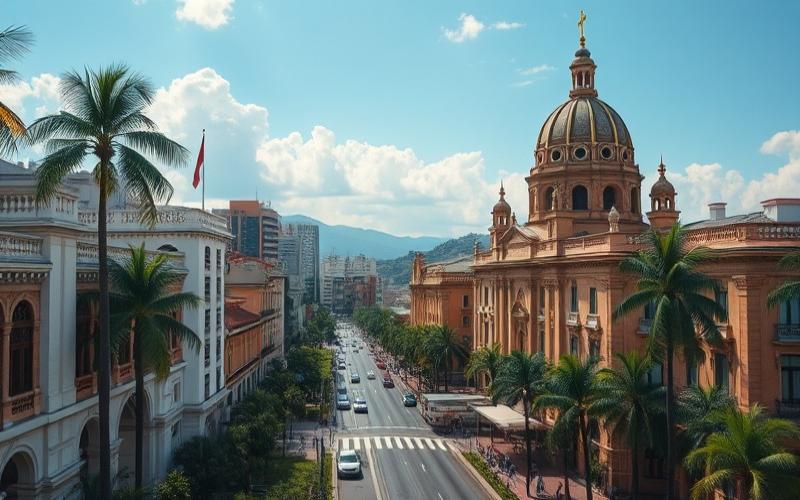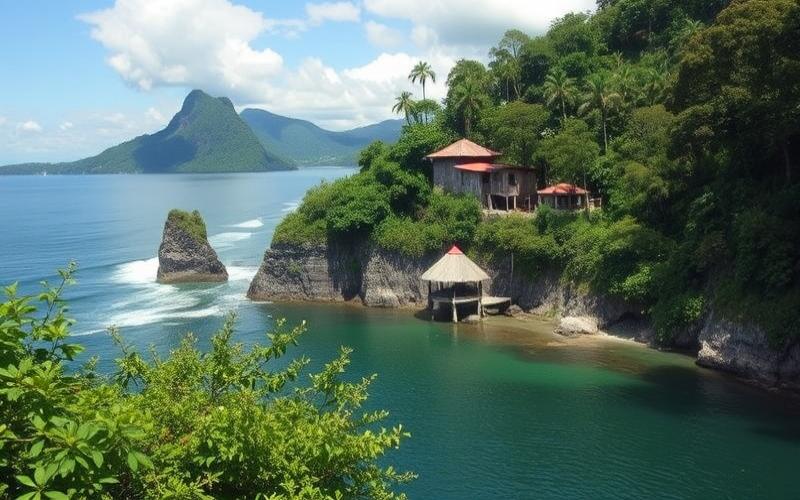
 Published on and written by Cyril Jarnias
Published on and written by Cyril Jarnias
Facing steadily rising living costs and increasing demand for affordable housing, micro-apartments are emerging as an innovative solution in Costa Rica, attracting both young professionals and retirees seeking a minimalist lifestyle.
These compact living spaces, often located in strategic urban areas, not only provide an economical solution but also promote a more sustainable lifestyle by maximizing the use of limited resources.
At the heart of this trend lies a new approach to housing that combines modernity, functionality, and accessibility, enabling residents to live well with less and thereby address the pressing challenges of urban life in this developing country.
Micro-Apartments: A Strategic Choice for Tight Budgets in Costa Rica
Micro-apartments are establishing themselves as a strategic solution for tight budgets in Costa Rica, responding to specific economic and demographic dynamics:
Economic and Demographic Reasons for the Appeal of Micro-Apartments
- Growing urbanization: Demand for affordable housing is increasing in urban areas where land and rents are higher.
- Evolving lifestyles: More and more young professionals, students, and retirees prioritize independence and proximity to urban services while seeking economical solutions.
- Modest incomes and real estate inflation: Rising living costs and stagnant wages are increasing interest in less expensive housing options for both purchase and rental.
Financial Benefits of Micro-Apartments
| Housing Type | Average Monthly Rent | Maintenance Cost | Utilities |
|---|---|---|---|
| Micro-apartment | ₡440,000 | Low | Low |
| Standard 1-bedroom | ₡1,550,000 | Medium | Medium |
| 2-bedroom | ₡611,000 | High | Higher |
- Reduced purchase and rental prices: Micro-apartments feature average rents significantly lower than traditional apartments, enabling substantial savings.
- Lower maintenance costs and utilities: Limited space = lower costs for cleaning, maintenance, electricity, and air conditioning.
- Reduced tax burden: Property taxes and insurance fees are proportional to housing size, making them lower for micro-apartments.
Addressing Specific Needs of Budget-Conscious Populations
- Young professionals: Access to independent housing in city centers, close to employment hubs and services, with controlled monthly costs.
- Students: Ideal solution for those wanting to live near universities while minimizing commuting and expenses.
- Retirees: Opportunity to reduce living costs while remaining close to urban medical and social infrastructure.
Comfort and Quality of Life
- Optimized spaces: Smart layouts, multifunctional furniture, access to shared spaces (gyms, terraces, laundry rooms).
- Proximity: Walkable or public transport access to shops, parks, cultural centers, and essential services.
Impact on Local Real Estate Market and Promotion Initiatives
- Urban market stimulation: Micro-apartments encourage high-density housing construction, accommodating more residents in city centers.
- Supply adaptation: Real estate developers increasingly offer residences specifically designed for this segment, with attractive pricing and shared services.
- Public or private support: Some government initiatives or public-private partnerships aim to facilitate housing access for moderate-income individuals, particularly through simplified procedures and micro-apartment quotas in new urban projects.
List of Main Benefits of Micro-Apartments in Costa Rica
- Low entry cost (purchase or rental)
- Reduced monthly expenses
- Easy access to urban centers and employment
- Adaptation to contemporary lifestyles
- Flexibility for students, young professionals, and retirees
- Contribution to controlled urban densification
⧉ Micro-apartments thus represent a concrete and flexible response to current economic and demographic constraints, while offering a quality of life adapted to the contemporary needs of budget-conscious urban residents. ⧉
Good to Know:
In Costa Rica, micro-apartments prove to be a smart option for those with modest budgets, particularly attracting young professionals, students, and retirees seeking to minimize their urban expenses. With purchase and maintenance costs significantly lower than traditional housing, these small spaces enable more reasonable financial management while providing essential comfort. The economic appeal of micro-apartments is reinforced by government and private sector initiatives aimed at promoting this type of housing, which also stimulates the local real estate market by offering affordable and practical alternatives in the face of rising prices in major cities. Efforts to make these homes more accessible fit within a demographic context where demand for housing solutions adapted to modern lifestyles is increasing, thus fostering a more inclusive and sustainable urban dynamic.
Microliving in Costa Rica: A Booming Trend
The rise of microliving in Costa Rica is explained by a combination of economic, demographic, and sociocultural factors transforming the urban real estate market.
Economic and Demographic Factors Favoring Micro-Apartments:
- Rising real estate prices in urban and coastal areas: The average cost per square meter in cities like San José or Jacó often exceeds $2,000 USD, making traditional housing less accessible, particularly for young professionals, expatriates, and investors.
- Growing demand for affordable solutions: Faced with increasing living costs and rents, micro-apartments significantly reduce housing expenses while remaining close to activity centers or sought-after beaches.
- Urbanization and densification: Population growth in the Central Valley and tourist areas promotes the development of compact housing to meet demand in limited urban spaces.
How Micro-Apartments Meet Resident Needs:
- Reduced housing costs: Micro-apartments offer lower rents or purchase prices than traditional apartments while allowing residence in central or trendy neighborhoods.
- Space and resource optimization: Minimalist layouts and integration of modular features (foldable furniture, shared spaces) maximize comfort in small areas.
- Easy access to urban services: Living in a micro-apartment downtown provides proximity to transportation, shops, coworking spaces, and entertainment, reducing the need for cars.
Cultural and Social Influences on Microliving Appeal:
- Young professionals: Attracted by flexibility, urban living, and the possibility of investing in a first property, they prefer compact housing for its practicality and controlled cost.
- Expatriate retirees: Many seek a simplified lifestyle without maintenance constraints, in safe and dynamic neighborhoods, often with shared services (security, maintenance, green spaces).
- Digital nomads: The rise of telecommuting and remote work has increased demand for temporary, well-located housing adapted to a mobile and international lifestyle.
| Target Audience | Main Motivations | Microliving Advantages |
|---|---|---|
| Young professionals | Urban living, reduced cost, flexibility | Affordable rent, proximity, modern design |
| Expatriate retirees | Simplicity, security, limited maintenance | Shared services, social integration |
| Digital nomads | Mobility, connectivity, temporary rental | Central locations, high-speed internet |
Impact on Real Estate Market and Future Urban Developments:
- Stimulation of condo and studio market: Demand for compact housing fuels construction of new mixed-use buildings with common areas and shared living solutions.
- Price pressure in desirable neighborhoods: The arrival of international buyers and new tenant profiles contributes to maintaining high per-square-meter prices in central areas.
- Evolution of construction standards: Developers integrate sustainability, energy efficiency, and space optimization criteria, reflecting expectations of a cosmopolitan clientele concerned about environmental impact.
- Transformation of urban fabric: The rise of micro-apartments could lead to increased densification, revitalization of central neighborhoods, and emergence of new urban innovation hubs.
Microliving in Costa Rica is establishing itself as an innovative response to contemporary economic, demographic, and cultural challenges, redefining urban lifestyles and real estate development strategies.
Good to Know:
In Costa Rica, the microliving trend is gaining momentum, driven by economic and demographic factors such as rapid urban population growth and increasing living costs. Micro-apartments thus offer an attractive solution for those seeking to minimize expenses while residing in desirable urban areas. This lifestyle particularly appeals to young professionals, attracted by flexibility and practicality, as well as expatriate retirees and digital nomads in search of a simplified quality of life. Costa Rican culture, focused on simplicity and sustainability, also favors this trend. Consequently, the real estate market is experiencing unprecedented dynamism, pushing for adaptation in future urban developments to incorporate these compact yet functional spaces. This evolution ensures not only diverse accommodation options but also a renewal in how living spaces are designed to meet residents’ new needs.
Investing in Studios: Opportunities and Benefits
The micro-apartment real estate market in Costa Rica is experiencing sustained growth, driven by increasing demand for affordable housing in dynamic urban areas such as San José, Jaco, and the Greater Metropolitan Area (GAM). This trend offers attractive opportunities for investors looking to diversify their real estate portfolio.
Opportunities for Investors
- Continuous price growth: The national average price per m² reached $1,021 in 2025, up from $877 in 2023, with urban neighborhoods like Rohrmoser in San José exceeding $2,370/m². This dynamic values investments in the studio and micro-apartment segment.
- Strong rental demand: Property ownership is becoming more difficult for locals, fueling rental demand, particularly for affordable small spaces.
- Tight market: In cities like Jaco, demand exceeds supply, studios rent quickly, often above listed prices, strengthening market liquidity.
| Urban Area | Average Condo Price/m² (2025) | Rental Demand Trend |
|---|---|---|
| San José (Rohrmoser) | $2,371 | Very strong, especially young professionals |
| Jaco | $2,420 | Strong, tourist appeal |
| Central Valley | $2,371 | Growing, urban population |
| Tamarindo (coast) | $3,154 | Strong, expatriates and tourism |
Financial Benefits
- High rental yield potential: Studios show high occupancy rates due to demand from young professionals, expatriates, and students, optimizing rental income.
- Relative market stability: Despite price increases, diverse demand (locals, expatriates, tourists) limits risks of prolonged vacancy and ensures some resilience to economic cycles.
- Portfolio diversification: Micro-apartments offer a more accessible entry point, enabling multiple units and risk sharing.
Possible Tax Incentives
- Costa Rica offers tax incentives for real estate investment, particularly in certain areas or for projects meeting environmental or urban renewal criteria.
- Foreign investors benefit from a relatively stable and transparent legal framework, with the possibility of full property ownership.
Appeal for Expatriates and Young Professionals
Costa Rica’s growing popularity among expatriates, digital nomads, and young international professionals strengthens demand for modern, affordable studios in central neighborhoods near economic hubs.
This clientele primarily seeks flexible, well-located housing solutions with good value for money, favoring high occupancy of micro-apartments.
Key Takeaways
Investing in studios in Costa Rica stands out due to sustained rental demand, attractive yield potential, and relative market stability, while benefiting from an incentivizing tax context and strong appeal among expatriates and young professionals.
Good to Know:
Investing in studios in Costa Rica presents numerous opportunities for investors seeking to diversify their portfolio, thanks to the sustained growth of the micro-apartment real estate market. The increasing demand for affordable housing in sought-after urban areas, like San José or Liberia, makes studios a financially attractive option with high rental yield potential and relative market stability. Investors can also benefit from various local tax incentives, making this investment even more interesting. Furthermore, Costa Rica attracts a growing number of expatriates and young professionals seeking economical housing solutions, thus ensuring high occupancy rates for micro-apartments. This appeal for affordable, well-located residences guarantees long-term profitability, making these real estate assets particularly promising in the country’s current context.
Small Space Returns: A Vision for the Future
Micro-apartments in Costa Rica illustrate a new approach to urban housing, focused on space optimization without compromising comfort. These homes, often under 20 m², respond to growing demand for affordable and ecological solutions in expanding cities.
Space Maximization and Residential Comfort
- Use of multifunctional partitions to delineate areas while integrating storage.
- Adoption of foldable beds, lofts, or beds concealed under platforms to free up living space during the day.
- Integration of modular or custom furniture, enabling quick room transformation according to needs (sleeping area, office, dining room).
- Installation of small multifunctional appliances to limit clutter while maintaining practicality.
Table – Interior Design Solutions in Costa Rican Micro-Apartments
| Solution | Main Function | Concrete Benefit |
|---|---|---|
| Foldable bed | Sleeping/Living room | Space saving during daytime |
| Storage partitions | Separation & storage | Square meter optimization |
| Modular furniture | Transformable furniture | Space versatility |
| Vertical storage | Height utilization | Increased storage capacity |
| Compact appliances | Kitchen/laundry | Reduced clutter |
Interior Design Innovations
Major innovations rely on:
- Height utilization to create high storage spaces accessible via foldable systems or integrated steps.
- Use of horizontal doors (like AVENTOS) that open upward to avoid obstructing movement.
- Ultra-thin drawers or storage in previously unused spaces (e.g., baseboards, nooks).
- Customization of furniture to adapt to each apartment’s configuration.
Economic and Environmental Impact
- Reduced construction cost: up to 30% less than traditional housing, making these homes more accessible for young professionals and investors.
- Decreased energy costs: reduced space = lower heating, air conditioning, or lighting needs.
- Reduced ecological footprint: fewer materials needed, less waste generated during construction, and frequent integration of prefabrication processes and local or recycled materials.
- Development of energy autonomy (solar panels, water collectors, composting).
Emerging Trends in Sustainable Construction
- Prefabrication and modularity: rapid construction, less disruption, better waste management.
- Use of bio-based or recycled materials to limit environmental impact.
- Strengthened environmental standards in coastal and urban areas, encouraging integration of water and energy management solutions.
- Regulatory flexibility: absence of minimum size for housing allows innovation and adaptation to local needs.
List of Benefits for Costa Rican Urban Areas
- Response to housing crisis: possible densification without land artificialization.
- Economic solution for young populations and modest households.
- Contribution to combating urban sprawl.
- Adaptation to tropical climate through materials resistant to humidity and natural ventilation.
Micro-apartments in Costa Rica are establishing themselves as an innovative and sustainable solution to address urban pressure and environmental challenges, while offering residents comfortable, flexible, and affordable living conditions.
Good to Know:
Micro-apartments in Costa Rica prove to be an ingenious solution for maximizing space utilization while offering optimal comfort to residents, largely thanks to interior design innovations like modular and foldable furniture that transform limited spaces into multifunctional areas. According to recent statistics, these homes contribute to reducing their carbon footprint by 35% compared to traditional constructions and enable significant savings for residents in terms of energy costs. Sustainable construction trends, such as the use of recycled materials and integration of solar energy technologies, are shaping the future of these micro-apartments, potentially offering a viable solution for economic housing challenges in rapidly expanding urban areas of Costa Rica.
Disclaimer: The information provided on this website is for informational purposes only and does not constitute financial, legal, or professional advice. We encourage you to consult qualified experts before making any investment, real estate, or expatriation decisions. Although we strive to maintain up-to-date and accurate information, we do not guarantee the completeness, accuracy, or timeliness of the proposed content. As investment and expatriation involve risks, we disclaim any liability for potential losses or damages arising from the use of this site. Your use of this site confirms your acceptance of these terms and your understanding of the associated risks.















































